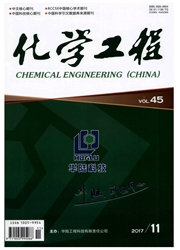

 中文摘要:
中文摘要:
利用吉布斯自由能最小原理,在Aspen Plus的Gibbs反应器模块中对传统西门子法还原过程进行模拟分析。考察了主要操作参数对多晶硅和副产物的转化率及能耗的影响。经过工艺参数优化,得到压力为100 kPa,氢气与三氯氢硅摩尔比为3/1时,多晶硅产率为44%,能耗为0.0185 GJ/kg。同时模拟了在传统工艺的进料中加入二氯二氢硅,得到在100 kPa下,二氯二氢硅、三氯氢硅和氢气摩尔比为1∶1∶5时,与传统工艺相比多晶硅产率提高9.5%,四氯化硅产率降低8.5%,能耗降低33%,节约氢气16.7%。
 英文摘要:
英文摘要:
The simulations of Siemens process were performed in the Gibbs reactor module of Aspen Plus software based on the Gibbs principle of minimum free energy.The effects of several key operational parameters on the equilibrium yields of polycrystalline silicon and other by-products as well as the energy consumption of process were comprehensively simulated and discussed.By virtue of the optimization of process parameters,the simulation results indicate that the best operational conditions of pressure and the mole ratio of hydrogen and trichlorosilane are 100 kPa and 3∶1 ,respectively,at which the production efficiency of polysilicon is 44%and the energy consumption is 0.018 5 GJ/kg.In addition,the advanced Siemens-based process of introducing dichlorosilane into feedstock at 100 kPa and the mole ratio of SiH2 Cl2/SiHCl3/H2 of 1∶1∶5 was also simulated.The simulated results were compared with that of the conventional process,indicating that the productivity of polysilicon is increased by 9 .5%and tetrachlorosilane is reduced by 8.5%;the energy consumption is decreased by 33%and hydrogen is saved by 16.7%.
 同期刊论文项目
同期刊论文项目
 同项目期刊论文
同项目期刊论文
 Simulation of CO2-Oil Minimum Miscibility Pressure (MMP) for CO2 Enhanced Oil Recovery (EOR) using N
Simulation of CO2-Oil Minimum Miscibility Pressure (MMP) for CO2 Enhanced Oil Recovery (EOR) using N Investigation of Mass-Transfer Performance for CO2 Absorption into Diethylenetriamine (DETA) in a Ra
Investigation of Mass-Transfer Performance for CO2 Absorption into Diethylenetriamine (DETA) in a Ra Experimental studies of regeneration heat duty for CO2 desorption from diethylenetriamine (DETA) sol
Experimental studies of regeneration heat duty for CO2 desorption from diethylenetriamine (DETA) sol Comprehensive mass transfer and reaction kinetics studies of a novel reactive 4-diethylamino-2-butan
Comprehensive mass transfer and reaction kinetics studies of a novel reactive 4-diethylamino-2-butan Comparative studies of heat duty and total equivalent work of a newheat pump distillation with split
Comparative studies of heat duty and total equivalent work of a newheat pump distillation with split A novel reactive 4-diethylamino-2-butanol solvent for capturing CO2 in the aspect of absorption capa
A novel reactive 4-diethylamino-2-butanol solvent for capturing CO2 in the aspect of absorption capa Experimental study on mass transfer and prediction using artificial neural network for CO2 absorptio
Experimental study on mass transfer and prediction using artificial neural network for CO2 absorptio Experimental analyses of mass transfer and heat transfer of post-combustion CO2 absorption using hyb
Experimental analyses of mass transfer and heat transfer of post-combustion CO2 absorption using hyb Kinetics of CO2 Absorption into a Novel 1-Diethylamino-2-propanol Solvent Using Stopped-flow Techniq
Kinetics of CO2 Absorption into a Novel 1-Diethylamino-2-propanol Solvent Using Stopped-flow Techniq Analysis of Mass Transfer Performance of Monoethanolamine-Based CO2 Absorption in a Packed Column Us
Analysis of Mass Transfer Performance of Monoethanolamine-Based CO2 Absorption in a Packed Column Us 期刊信息
期刊信息
